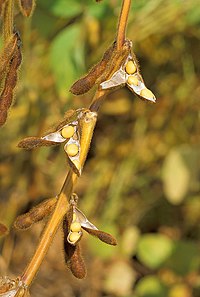
Photo from wikipedia
Abstract Soil-borne, plant parasitic nematodes are potentially agronomically and economically damaging in the wheat (Triticum aestivum L.)-soybean (Glycine max L.), double-crop production system that is common in the mid-southern United… Click to show full abstract
Abstract Soil-borne, plant parasitic nematodes are potentially agronomically and economically damaging in the wheat (Triticum aestivum L.)-soybean (Glycine max L.), double-crop production system that is common in the mid-southern United States. Double-crop field studies with at least five years of consistent management are rare, but can provide a valuable setting to assess long-term, and potentially cumulative, management practice effects on nematode abundance and root damage. The objective of this study was to evaluate the effects of a combination of management practices including residue burning (burned and no burn)-irrigation (irrigated and non-irrigated), wheat residue level (high and low), and tillage (conventional tillage and no-tillage) practices on plant parasitic nematode soil abundance and reproduction on soybean 34 and 70 days after planting following 14 complete cropping cycles in a wheat-soybean, double-crop production system on a silt-loam soil in eastern Arkansas. Stunt and total nematode abundances were at least 8.2 and 4.2 times greater (P
Journal Title: Applied Soil Ecology
Year Published: 2017
Link to full text (if available)
Share on Social Media: Sign Up to like & get
recommendations!